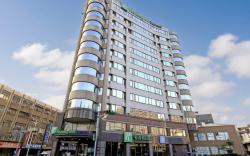Gyeongbokgung Palace Introduction
Jingfu Temple, located in the center of Taoyuan City, is both a religious sanctuary and a testament to cultural history. As an important faith center in the Taoyuan area, Jingfu Temple, known as a "great temple," has long integrated into the lives and emotions of the local residents. Moreover, the festive activities held here make it a popular highlight for cultural tourism. With a rich history, the roots of Jingfu Temple can be traced back to 1745, when it was jointly built by immigrants from Zhangzhou, Fujian. The temple is primarily dedicated to the Kaizhang Shengwang, with its incense originating from Zhangzhou. As the number of immigrants increased in 1811, the original temple's scale was insufficient to reflect the significance of their faith, leading to a decision to expand it. The expansion began in 1811 and, after two years of effort, was completed in 1813, enlarging the temple to a scale of three main halls. The rear hall is particularly dedicated to Guanyin, showcasing the diversity of faith. During this reconstruction, renowned craftsmen from Zhangzhou were invited to carve seven significant deity statues. Among these, the statue of the Shengwang Gong is the largest and most exquisite representation of the Kaizhang Shengwang in Taiwan's Qing Dynasty sculpture, evoking reverence in visitors with its solemn and compassionate demeanor. Jingfu Temple's architectural style blends traditional Taiwanese techniques. Inside the temple, plaques and stone pillars commemorate the craftsmanship of Qing Dynasty artisans. The designs of the front hall and main hall were created by masters Chen Yingbin and Wu Haitong, forming a perfect aesthetic hall of architecture and art. Additionally, the water dragon pool in the temple courtyard and nighttime lighting design add vibrancy and charm to this historical structure. Active throughout the year, Jingfu Temple hosts a variety of festive activities. From the ritual of offering incense on New Year's Eve to the lively celebrations of the Kaizhang Shengwang's birthday, each event is filled with historical warmth and deep cultural traditions. Other special activities include Mother's Day events, elegant rites of passage, solemn ceremonies during the Ghost Festival, romantic matchmaking organized by the God of Love, and the spectacular water lantern ceremony, all providing visitors with multifaceted cultural experiences. Beyond architecture and activities, Jingfu Temple also offers a variety of creative cultural products. From keychains symbolizing peace to pendants that convey wisdom, and from commemorative bracelets and fortune coins to auspicious gold spades and charm bracelets, even wooden divination cups have become popular collectibles. These items are practical yet rich in cultural significance, making them the perfect souvenirs for visitors.






































